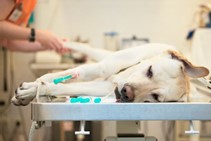You may have given blood yourself or volunteered at a blood donor clinic but did you know that dogs also give blood? In 1996 the Canadian Animal Blood Bank (CABB) was established to:
- Supply high quality canine blood products to Canadian veterinarians.
- Advance veterinary medicine by educating Veterinarians and Veterinary Technicians/Animal Health Technologists in transfusion medicine.
- Increase public awareness of animal blood banking.
The CABB is a not-for-profit charity whose headquarters are based in Winnipeg, MN with satellite collection sites based out of Calgary, Edmonton, various Southern Ontario locations, Université de Montréal (CHUV) and Moncton NB.
The need for canine blood is as great as it is for human blood, so how can you help? For your dog to become a blood donor, it needs to fall within these criteria:
- Be a minimum of 55 lbs in weight.
- Fall within the age range of 1-8 years old.
- Be able to lie still for about 5 minutes.
- In these COVID times, not be concerned that its owner will not be by his / her side during the procedure.
- Be physically fit to give blood and be OK’d by the dog’s regular vet clinic.
- Be up-to-date with vaccines.
Because canine blood only has a shelf life of about 30 to 35 days, supplies need to be constantly replenished. When a donor dog is approved to give blood, he/ she usually donates about every month-and-a-half to two months. A typical donation will see a dog contribute 450 millilitres, the equivalent of what a human would donate.
Dogs have more than 13 blood types and have more than eight antigens attached to their red blood cell which is denoted by Dog Erythrocytes Antigen (DEA). These DAES can be divided into the following eight types: DAE 1.1, DAE 1.2, DAE 3, DAE 4, DAE 5, DAE 7 and DAE 8. Dogs that are DAE 1.1 negative are considered as universal donors. According to www.dog-health-handbook.com “60% of Greyhounds are universal donors. Boxers, Irish Wolfhounds, German Shepherds, Dobermans, and Pit Bulls are often universal donors as well. This is important because only dogs with a universal dog blood type (DEA 1.1 negative) can be blood donors.”
Although canine and human bloods are quite similar, there are certain differences:
- The blood of a dog has usually 4 to 8 percent greater chloride content than human blood.
- There is less bicarbonate in dogs’ blood in comparison to humans.
- The lactic acid concentration at rest in the dogs is much more variable than that of humans.
- In the blood of dogs, red blood cells contain little potassium as compared to humans.
As www.thesprucepets.com tells us, dogs need blood transfusions for a variety of reasons such as disease, surgery and trauma. Examples would include Parvovirus infection or rat poison toxicity.
Human and canine blood is not interchangeable because of the different structures and types of blood.
So what’s in it for the donor dogs? Plenty of treats and a dashing red donor bandana.
Although not associated with the CABB, Community Therapy Dogs has played a small part in helping boost the blood supply. Taylor, one of our therapy dogs living in Strathmore, gives blood on a regular basis and, apparently, thoroughly enjoys the experience.
So, if you and your dog would like to explore the world of canine blood donations and your dog fits the criteria above, contact the Langdon Vet Clinic on 403-936-4571 as they are holding a blood donor clinic on Sunday May 16th.
As Canadian Blood Services says “it’s in you to give”: so too is it for your dog.






